The Intel Comet Lake Core i9-10900K, i7-10700K, i5-10600K CPU Review: Skylake We Go Again
by Dr. Ian Cutress on May 20, 2020 9:00 AM EST- Posted in
- CPUs
- Intel
- Skylake
- 14nm
- Z490
- 10th Gen Core
- Comet Lake
Power
We kind of gave a sneak preview on the front page with our frequency graph, but the short answer as to whether these new Core i9 processors really need 250 W for 10 cores is yes. Intel sent us details on what it has determined should be the recommended settings for its K processor line:
- Core i9-10900K: TDP is 125 W, PL2 is 250 W, Tau is 56 seconds
- Core i7-10700K: TDP is 125 W, PL2 is 229 W, Tau is 56 seconds
- Core i5-10600K: TDP is 125 W, PL2 is 182 W, Tau is 56 seconds
For those not used to these terms, we have the TDP or Thermal Design Power, which is meant to be the long-term sustained power draw of the processor at which Intel guarantees the base frequency of the processor – so in this case, the Core i9-10900K guarantees that with a heavy, long-running workload it will max out at 125 W with a frequency of at least 3.7 GHz (the base frequency).
The PL2 is known as the turbo power limit, which means that while the processor is allowed to turbo, this is the upper power limit that the processor can reach. As mentioned on the first page of this review, the value for PL2 is only a suggested guide, and Intel lets motherboard vendors set this value to whatever they want based on how well the motherboard is designed. Sometimes in laptops we will see this value lower than what Intel recommends for thermal or battery reasons, however on consumer motherboards often this value is as high as it can possibly be.
The final term, Tau, is meant to be a time by which the turbo can happen. In reality the TDP value and the Tau value is multiplied together to give a value for a ‘bucket’ of energy that the processor can use to turbo with. The bucket is refilled at a continuous rate, but if there is excess energy then the processor can turbo – if the bucket is being emptied at the same rate as it is refilled, then the processor is down at the long-term TDP power limit. Again, this is a value that Intel recommends and does not fix for the vendors, and most consumer motherboards have Tau set to 999 seconds (or the equivalent of infinite time) so the processor can turbo as much as possible.
Note, when we asked Intel about why it doesn’t make these hard specifications and how we should test CPUs given that we’re somewhat enable to keep any motherboard consistent (it might change between BIOS revisions) for a pure CPU review, the response was to test a good board and a bad board. I think that on some level Intel’s engineers don’t realize how much Intel’s partners abuse the ability to set PL2 and Tau to whatever values they want.
All that aside, we did some extensive power testing on all three of our CPUs across a number of simulation and real-world benchmarks.
Core i9-10900K Power
Through our tests, we saw the Intel Core i9-10900K peak at 254 W during our AVX2-accelerated y-cruncher test. LINPACK and 3DPMavx did not push the processor as hard.
The more real-world tests, AI Benchmark and Photoscan, showed that in a variable operation workload mixing threads, we are more likely to see the 125-150 W range, with spikes up to 200W for specific operations.
For users interested in the voltage for our Core i9-10900K, we saw the processor peak at 1.34 volts, however even during an AVX2 workload it was nearer to 1.25 volts.
Intel Core i7-10700K
The Intel Core i7-10700K is rated by Intel to have a peak turbo power of 229 W, however our sample peaked at 207 W during y-Cruncher. LINPACK achieved similar results, whereas 3DPMavx was nearer 160 W.
Our AI Benchmark power wrapper failed for the 10700K due to a configuration issue, but the Photoscan ‘real world’ power test put the processor mostly in the 100-125 W range, peaking just below 150 W in a couple of places.
Intel Core i5-10600K
Intel’s Core i5-10600K has a recommended PL2 of 182 W, but we observed a peak of 125 W in y-Cruncher and 131 W in LINPACK.
We actually saw our AI Benchmark real-world test hit 130 W as well, while Photoscan was nearer the 60-80 W range for most of the test.
The full set of power graphs can be found here:
In terms of overall peak power consumption, our values look like this:
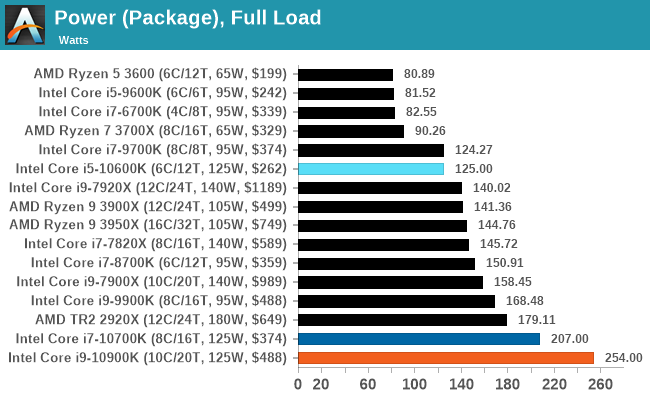
Note, 254 W is quite a lot, and we get 10 cores at 4.9 GHz out of it. By comparison, AMD's 3990X gives 64 cores at 3.2 GHz for 280 W, which goes to show the trade-offs between going wide and going deep. Which one would you rather have?



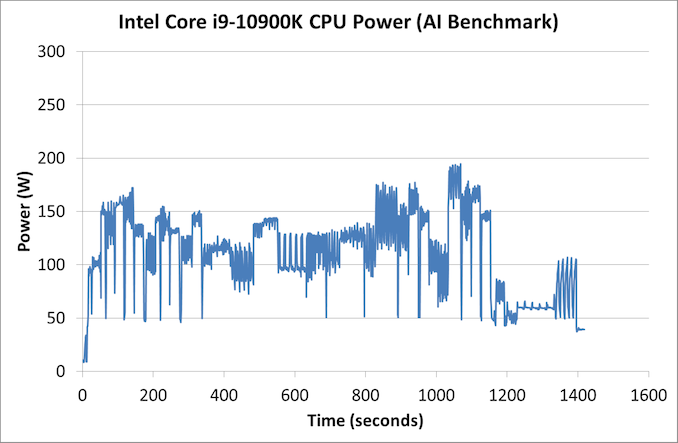
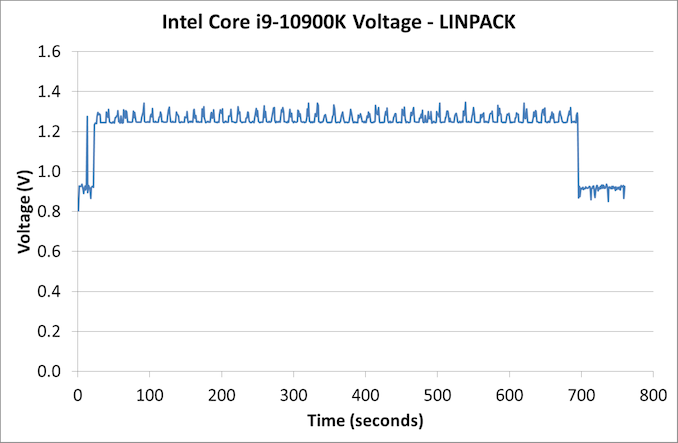
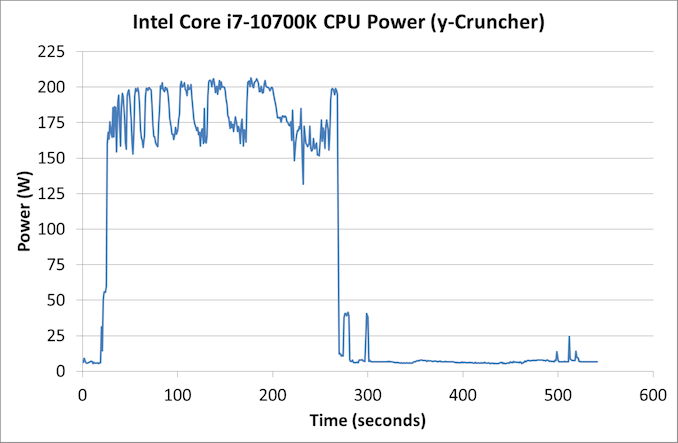
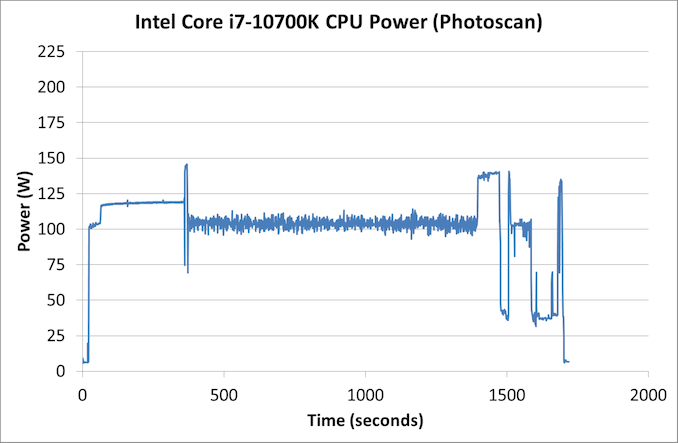
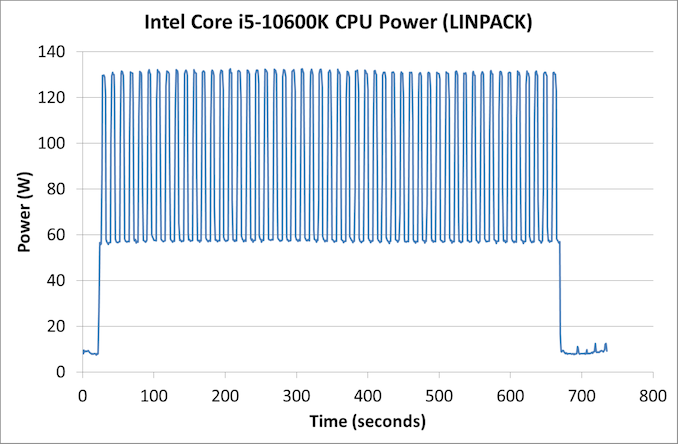
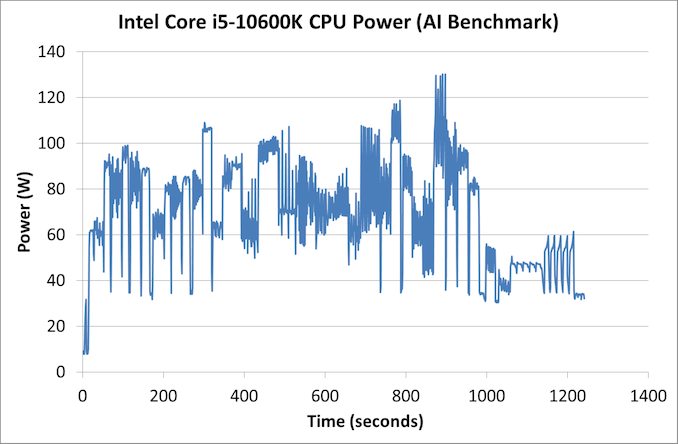














220 Comments
View All Comments
Khenglish - Wednesday, May 20, 2020 - link
Ian, for the Crysis CPU render test you'd probably get higher FPS disabling the GPU in the device manager and set Crysis to use hardware rendering. Disabling the GPU driver enables software rendering by default on Windows 10. The Win10 rendering does stutter worse than the reported FPS though, so take from it what you want.shaolin95 - Wednesday, May 20, 2020 - link
"But will the end-user want that extra percent of performance, for the sake of spending more on cooling and more in power?"Such retarded comment. More power...do you actually know who little difference this makes in a year. Wow this place is going down hill fast.
Oh and a cooler you know we don't have to change our cooler with every CPU purchase so don't make it seem like this HUGE issue...your AMD fanboy colors are showing VERY clearly.
schujj07 - Wednesday, May 20, 2020 - link
If you think you can use the 212 EVO you have from a 6700k or 7700k to keep the 10900k cool you are absolutely nuts. "Speaking with a colleague, he had issues cooling his 10900K test chip with a Corsair H115i, indicating that users should look to spending $150+ on a cooling setup. That’s going to be a critical balancing element here when it comes to recommendations." This isn't any form of fanboyism. This is stating a fact that to squeeze out the last remaining bits of performance in Skylake & 14nm Intel had to sacrifice massive amounts of heat/power to do so.Maxiking - Wednesday, May 20, 2020 - link
If you have issues cooling 10900k with H115i, the problem is always between the monitor and chair.They were able to cool OC 10900k with 240m AIO just lol
Incompetency of some reviewers is just astonishing
schujj07 - Wednesday, May 20, 2020 - link
All depends on the instructions that you are running. From Tomshardware: "We tested with the beefier Noctua NH-D15 and could mostly satisfy cooling requirements in standard desktop PC applications, but you will lose out on performance in workloads that push the boundaries with AVX instructions. As such, you'll need a greater-than-280mm AIO cooler or a custom loop to unlock the best of the 10900K. You'll also need an enthusiast-class motherboard with beefy power circuitry, and also plan on some form of active cooling for the motherboard's power delivery subsystem." https://www.tomshardware.com/reviews/intel-core-i9..."While Intel designed its 250W limit to keep thermals 'manageable' with a wide variety of cooling solutions, most motherboard vendors feed the chip up to ~330W of power at stock settings, leading to hideous power consumption metrics during AVX stress tests. Feeding 330W to a stock processor on a mainstream motherboard is a bit nuts, but it enables higher all-core frequencies for longer durations, provided the motherboard and power supply can feed the chip enough current, and your cooler can extract enough heat.
To find the power limit associated with our chip paired with the Gigabyte Aorus Z490 Master motherboard, we ran a few Prime95 tests with AVX enabled (small FFT). During those tests, we recorded up to 332W of power consumption when paired with either the Corsair H115i 280mm AIO watercooler or a Noctua NH-D15S air cooler. Yes, that's with the processor configured at stock settings. For perspective, our 18-core Core i9-10980XE drew 'only' 256W during an identical Prime95 test." https://www.tomshardware.com/reviews/intel-core-i9...
Think it is still a pebkac error?
alufan - Thursday, May 21, 2020 - link
try this he doesn't slate the intel or amd just a proper review with live power draw at the socket OMG lol you need your won power plant when you run these let alone over clock ithttps://www.kitguru.net/components/leo-waldock/int...
Spunjji - Tuesday, May 26, 2020 - link
"They were able to cool OC 10900k with 240m AIO just lol"Who were? Everyone I've read indicates that with a 240mm AIO, CPU temps hit 90+
Pathetic comment troll is pathetic.
Retycint - Wednesday, May 20, 2020 - link
It is, in fact, a huge issue because most people won't have high end coolers necessary to keep the thermals under control. Personal attacks such as accusing people of being a "fanboy" just degrades your argument (if there was any in the first place) and make you look dumbSpunjji - Tuesday, May 26, 2020 - link
"Such retarded comment."The pure, dripping irony of using a slur to mock someone else's intelligence, but screwing up the grammar of the sentence in which you do it...
Some people build from scratch. Some people have uses for their old system. larger PSUs and suitable cooling to get optimal performance from this CPU don't come cheap. Go home, troll.
watzupken - Wednesday, May 20, 2020 - link
Not surprising, Intel managed to keep their advantage in games by pushing for higher frequency. However the end result is a power hungry chip that requires some high end AIO or custom water cooler to keep cool. I agree that Intel is digging themselves deeper and deeper into a hole that they will not be able to get out so easily. In fact I don't think they can get out of it until their 7nm is ready and mature enough to maintain a high frequency, or they come out with a brand new architecture that allows them to improve on Comet Lake's performance without the crazy clockspeed. Indeed, they will not be able to pull another generation with their Skylake + 14nm combination looking at the power consumption and heat generation issue. Intel should consider bundling that industrial chiller they used to cool their 20 core chip during the demo.